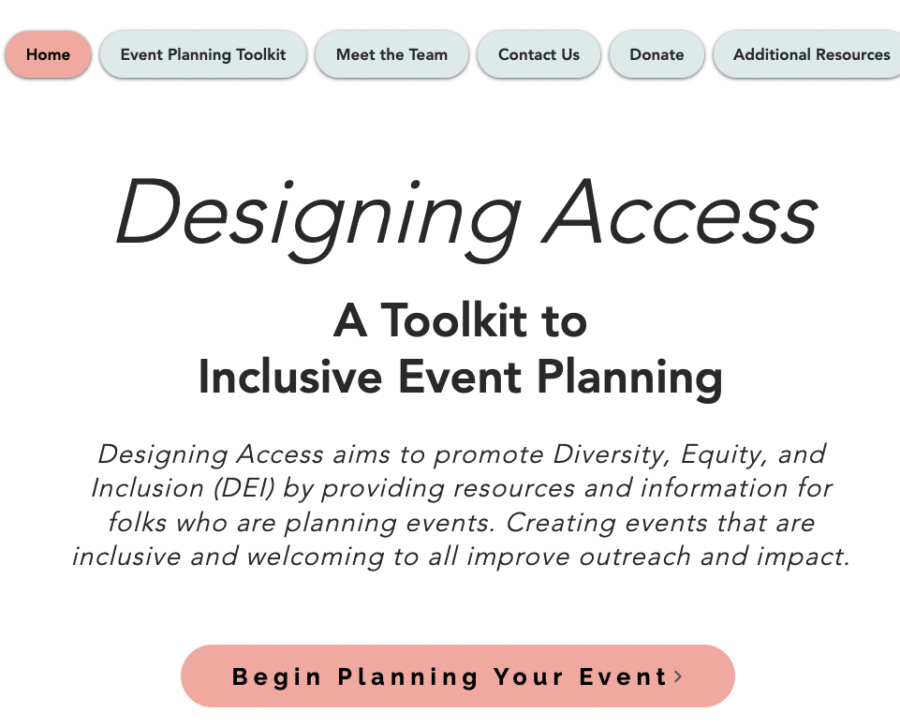Designing Access: One Year Later
We recently sat down with the Designing Access team to talk about what they’ve been up to since participating in Innovation in Action (IiA) 2021. After the IiA Final Showcase, they won the Envisioning an Anti-Racist World award for their inclusive event planning toolkit.
Story by Sydney Moore
They came away from the experience eager to start piloting the website that houses their expansive toolkit, first within the School of Social Work and eventually beyond academia. If you’d like to check out our original article on their work, it can be found on the C-SED website, or you can check out Designing Access’s new website.
Can you Provide a Brief Description of your Mission?
The Designing Access toolkit guides leaders step-by-step through the process of planning inclusive and accessible events using a Diversity, Equity, and Inclusion (DEI) lens. We help organizations create spaces where people feel comfortable fully expressing themselves and where each individual’s participation is welcomed and meaningfully integrated.
What progress have you made in the Design Process?
After IiA, we had to regroup a bit because two of our founding members respectfully decided to step away after graduating. However, the rest of us, Hannah Lefton, Callie Torkelson, and Flavio Stefano, wanted to keep working, balancing this project with our full-time jobs and course loads. Since then, we brought on Shey Pemberton in the summer of 2021 for extra support with the technical side and user research. Beyond that though, we’ve remained a pretty small and collaborative team.
We have already done a round of prototyping with about twenty people, and Shey implemented the feedback that we received from that. Currently, we are working through a second round of feedback and hoping to do a third round with a wider net. Moreover, we are very grateful for the fact that we have received the School of Social Work’s Anti-Racism Fund Individual Student Project Grant three times already, as this has greatly helped us continue our work. It has also served as an additional source of feedback.
As far as how the way in which we operationalize this work has changed, we’ve recently realized that there’s a lot more information and ways to carry out this work then what we are focusing on. For example, you don’t have to rely solely on a website, as workshops and 1:1s with potential clients could add a lot of value to the experience. We’ve started considering these additional options in our meetings, but they are all in the ideation stage for now.
On top of that, we got the chance to help run the School of Social Work design challenge focused on antiracism. This past fall was its first year. And while it was run online, we learned a lot from the experience, and we got to work in conjunction with Erin Moore from C-SED, who was heavily involved in our IiA experience.
What kind of feedback are you getting?
First of all, we were surprised by the level of enthusiasm people held towards our product. A lot of them asked us how much we were going to charge, which is something we originally hadn’t thought about. So, we’ve been working on implementing a fair payment system. This mindset is different from our social work mindset. Moreover, people have asked if we would be willing to sell our toolkit as a pdf. It’s been a nice reminder that there are physical ways to share this work, and there’s still a significant demand for it. We also didn’t anticipate how innovative this project was going to be. We just assumed something similar already existed, but we haven’t found another comprehensive toolkit to date. Additionally, someone suggested that we give our clients an accessibility rating as a fun and competitive way to let organizations compare themselves in terms of accessibility and inclusion.
Looking Back to IiA 2021, What Advice Would you Give Yourselves?
The overall design process takes way longer than the IiA cycle, which is something we weren’t aware of when we started. We’ve all had to learn over time how the process doesn’t move as quickly as it could because it’s not a full time commitment for any of us. Similarly, we’ve discovered that it’s all about trusting the process. At first, we were overwhelmed by the fact that we could actually ‘make a thing’, especially coming from a social work background. But to be successful, you can’t design from an end-goal. Rather, you should keep your mind open to new solutions.
Want to know more? Read Designing Access’s first story, watch their 2021 final showcase presentation, or contact them to talk about integrating their DEI Toolkit into your planning: designingaccess@gmail.com.



